How to teach your horse to Stand-Stayso it will be a better helper for you.byCertified Farrier - Colt Starting Trainer
Jack Griffes
(517) 7 Five Nine - 2 Nine 1 8
Lenawee County, Michigan
United States of America
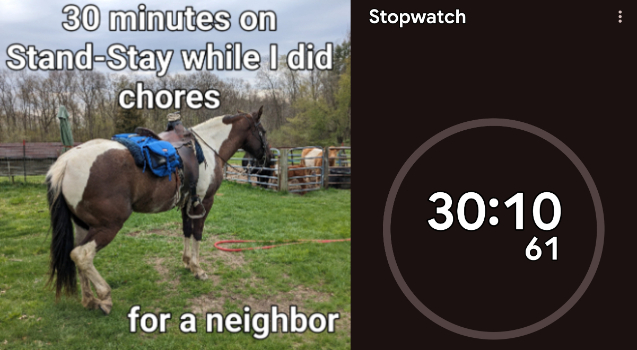
23 April 2024 - this is my 9-3/4yr old mare Avi whom I purchased as a green broke 7yr old which had not a clue about Stand-Stay.
Stand-Stay is one of the most used and most useful things I have taught Avi.
byCertified Farrier - Colt Starting Trainer
Jack Griffes
(517) 7 Five Nine - 2 Nine 1 8
Lenawee County, Michigan
United States of America

23 April 2024 - this is my 9-3/4yr old mare Avi whom I purchased as a green broke 7yr old which had not a clue about Stand-Stay.
Stand-Stay is one of the most used and most useful things I have taught Avi.
Jack Griffes
Lenawee County, Michigan
United States of America
Training horses always involves some risk of injury (or even death) to the horse, the trainer, any spectators, equipment used, etc. - this risk is totally your own as you will be making your own judgements on what to do. As with any suggestions on any subject you must weigh them out for yourself and proceed accordingly - at your own risk.
The starting foundation training for the Stand-Stay is that the horse pupil and the human teacher/trainer BOTH MUST KNOW AND AGREE that whoa means "stop and grow roots awaiting further direction." If the both of you are not there with the starting foundation in place then work together to get that starting foundation in place. There are many ways to do it and three of them are covered in my 1997 article entitled "How to teach your horse to stand perfectly calm while totally UNRESTRAINED for shoeing / trimming / etc." which can be found at https://griffes.tripod.com/stand.html I trust you will find that 1997 article is still very relevant to helping you do the foundation training for the Stand-Stay. To be a good horseman you must grasp that while the horse cannot learn to think like a human the human can learn to think like a horse to a large degree IF the human intentionally works to learn that foreign language and foreign way of thinking. To be a good horseman you must intentionally work on learning to "talk horse" (language & logic) so that you can both understand the horse and also be understood correctly by the horse. Consider how distressing it is to a flight response prey animal (horse) when a apex predator (human) speaks only "predator" talk to them (primarily by body language). And imagine the hope that takes root when that flight response prey animal (horse) sees/hears an apex predator (human) speaking horse to them - telling them in horse that they need not fear - helping them via their own logic deal with their anxiety - and clearly teaching them in their own language (primarily body language) rather than expecting them to somehow magically understand a foreign tongue which instinctively provokes fear in them. Some of that is covered in that 1997 article. Learning to talk "horse" (language & logic) is the pursuit of a lifetime for every good horseman and yes you can (from where you are right now) choose to intentionally work to become a good horseman.
In this article I am going to talk you through expanding the Stand-Stay so that your horse can be more helpful to you presuming you actually use your horse to do an array of jobs OR would like to be able to use your horse to actually help you do an array of jobs. Having a horse that will Stand-Stay quite reliably for quite a long while is VERY helpful to you if you use the horse to do an array of jobs.
First - YOU have to be consistent and quite candidly humans have to work hard to learn to be consistent because consistency is a KEY to good horsemanship. Your "whoa" cue needs to consistently mean just one thing - STOP and grow roots right there awaiting further direction. You must stop confusing the horse by saying "whoa" when you mean anything other than that one thing. You must be consistent. You must stop saying "whoa" when you really mean "easy" for one example - NO "whoa" does not mean go slower or transition down one gait (ex. from canter to trot) or a host of other instances when humans say "whoa" but do not really mean "STOP and grow roots right there awaiting further direction." So yes to make your horse better trained YOU must better train yourself to become consistent - to communicate precisely and correctly to your horse - to say what you mean and mean what you say - whether you say it aloud or via a rein cue or a leg cue or a seat cue. So FIRST be consistent.
Second - once you have taught the horse that "whoa" means "STOP and grow roots right there awaiting further direction" then start grooming and saddling/harnessing your horse on Stand-Stay. Tell it "whoa" and then bit by bit you expand its understanding that growing roots and awaiting further direction can be for a millisecond (because a rollback was cued as the stop was completed) or for a couple hours (because the horse is getting new winter shoes and anti-snowball pads all around). Obviously it takes lots and lots of repetitions to get the horse to Stand-Stay a long time - so get busy doing those reps - when you groom - when you tack up - when you untack. If the horse breaks the Stand-Stay you scold them a bit (typically this means back them up - by body language) and then put them back as close to exactly where they had been as possible (because horses are location conscious) and tell them "whoa" and then expect them to stay put. They will rise to your expectation (or lower to your expectations) so as they get better you keep setting your expectations that next little bit higher AFTER you "catch them doing good." Yes "catch them doing good" - praise them - stroke them (horses generally do NOT really like being patted - but do like being stroked).
Third - build trust. Trust is a two-way street with horses. Yes the horse needs to trust you and yes you need to trust your horse and BOTH sides need to build that relationship of trust "here a little and there a little" all of the time. At some point you are going to think your horse is ready to Stand-Stay by the door while you carry your saddle out of its sight into the tack room and you are going to have to trust the horse enough to give it a try. And it is going to have to trust you - that you are actually coming back and thus there is a valid reason to stay put awaiting further direction (because why should it just stand there if it doesn't think you are coming back). When you come back and it is standing right where you left it - you are going to praise that horse - tell it thanks - tell it did good - stroke it - you are going to make sure it knows you caught it doing good - and you are going to work hard at catching it doing good. And if it moved off you are going to catch it back up and set it back where it was supposed to stay and say "whoa" and walk off - but come back quicker so you can catch it doing good - and right then you are going to do a few reps - each one with you away just a wee bit longer before you return - a teaching moment has occurred so TEACH. Build trust - build your trust that the horse will Stand-Stay longer and longer and without the horse being able to see you. Work at it. And yes build your trust that the horse is rock solid on Stand-Stay when you can't see it.
And yes it is just that easy and yes it is just that hard. Every horse will learn at a different pace. You are simply teaching them to be responsible to be where you left them IF you told them to Stand-Stay by telling them "whoa" and truly meaning "STOP and grow roots right there awaiting further direction." And from experience doing LOTS of different jobs with horses I can testify that a horse that is solid at Stand-Stay is a MUCH better helper when doing a vast array of jobs - see one video and eight more photo examples below each with a written description below the photo. Candidly the one video and nine photo examples of Stand-Stay included in this article is a pittance because I personally use Stand-Stay to get my horse to be a better helper VERY often when we are out doing various jobs - but I do it so often - it is so common to me that I rarely think it is a photo worthy moment. Work at it - and it can become that commonplace to you as well.
Having a hard time believing? Watch this video - Avi was on Stand-Stay for a couple minutes before the video starts as can be seen by the branches already in the lariat loop. You can watch Avi patiently stand awaiting further direction for another couple minutes while I put more branches in, tighten up the loop, lay the rope (not the coils) across the horn, go behind her, pick the rope off the horn before I mount and mount. Yes it is possible. Now get your horse to do it this good OR BETTER.

In the photo above you see Nash, the Grulla gelding, on Stand-Stay - took photo from inside the house while getting batteries.
This was 5-1/2 weeks after Nash came into training with literally ZERO clue about Stand-Stay.
And yes Nash was standing right there when I got back outside and put the batteries in the saddlebags.
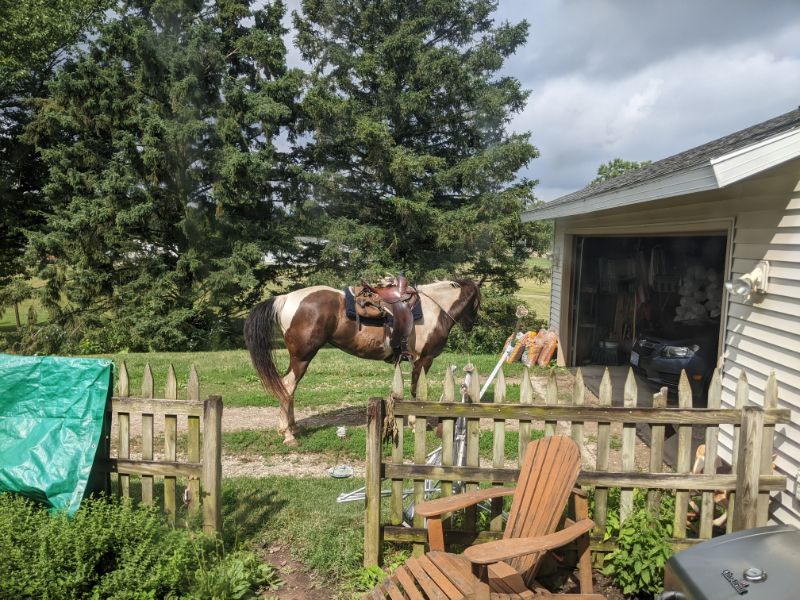
Avi on Stand-Stay after a milk run to the grocery store.
I took the photo from inside the house after putting the two gallons of milk in the refrigerator.
And yes Avi was still there when I got outside.
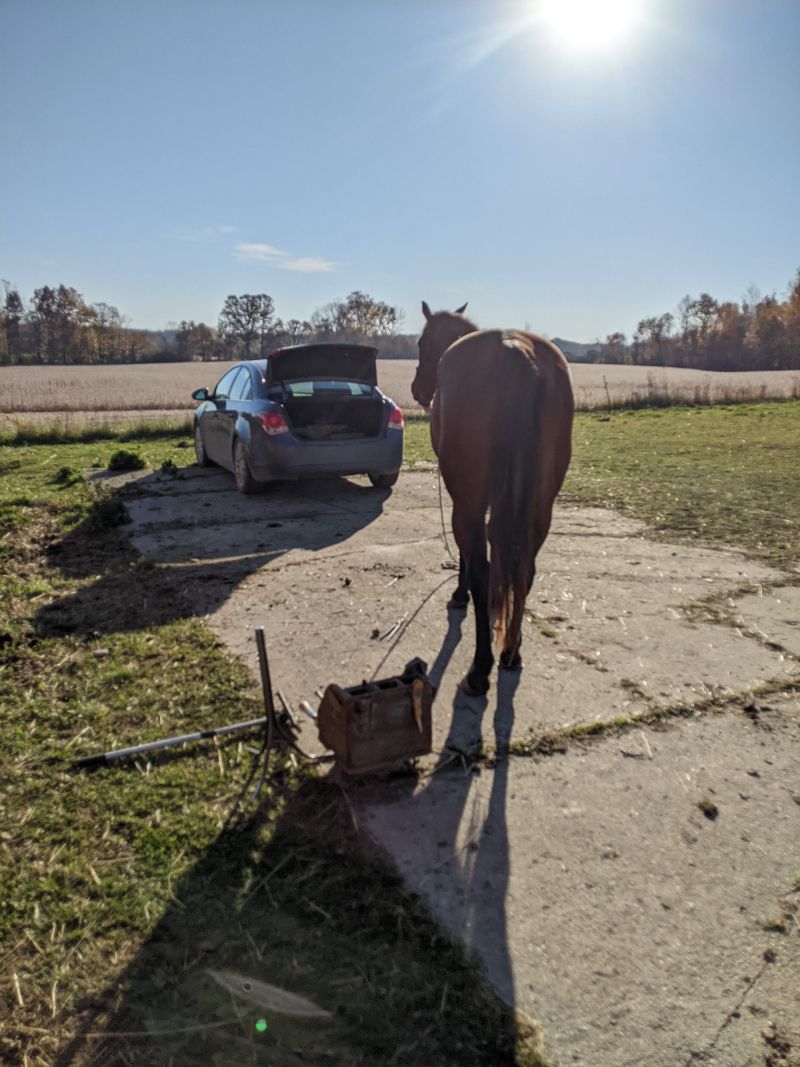
JJ the solid colored Paint on Stand-Stay while his shoes were reset all around.
I snapped the photo AFTER he had stood there not tied and nobody holding him while I reset all four shoes.
And as you can see he is still standing there - awaiting further direction.

Avi on Stand-Stay after being unsaddled.
I took the saddle in and put it on the saddle rack in the tack room, closed up the tack room, and came back out and took the photo.
Once you turn out of the aisle to go to the tack room the horse cannot see you.
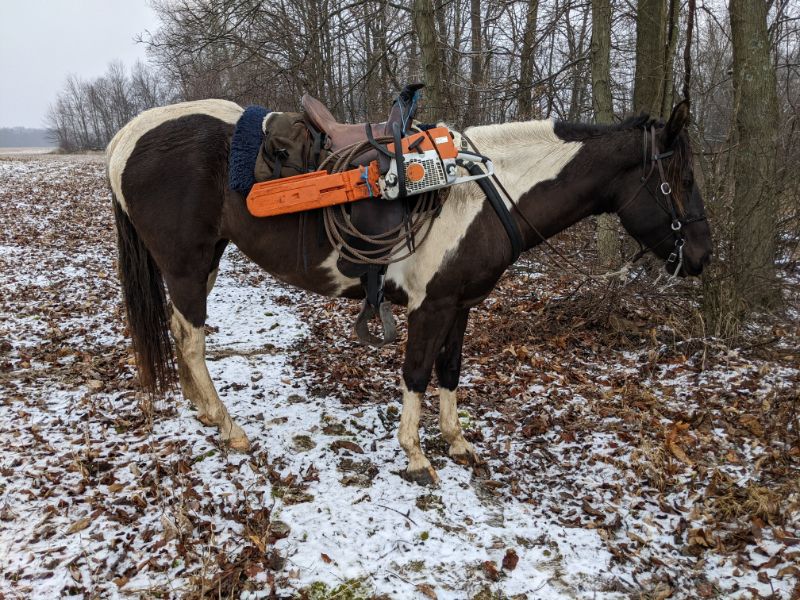
Avi on Stand-Stay while we are out cutting firewood logs to dally and drag home.
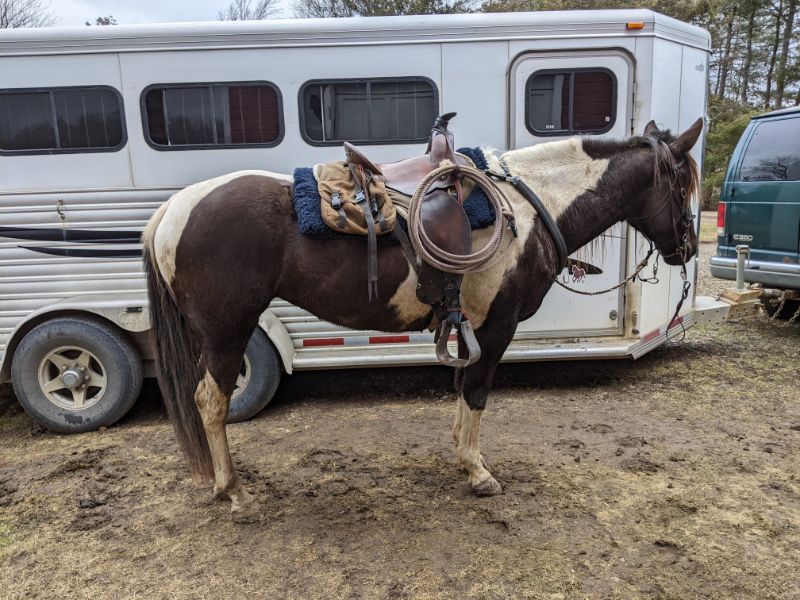
Avi on Stand-Stay when we are tacking and untacking by the trailer's tack room.
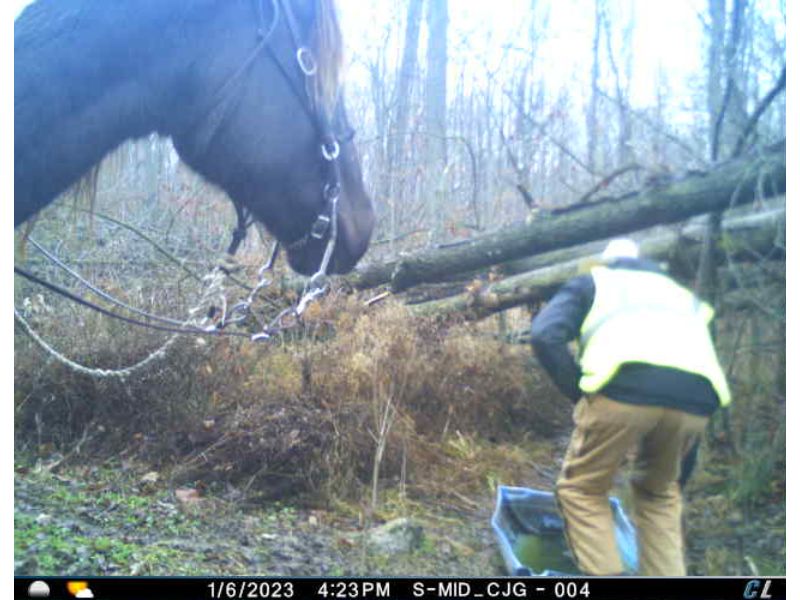
Avi on Stand-Stay while I work on a Wildlife Water Source in the woods.
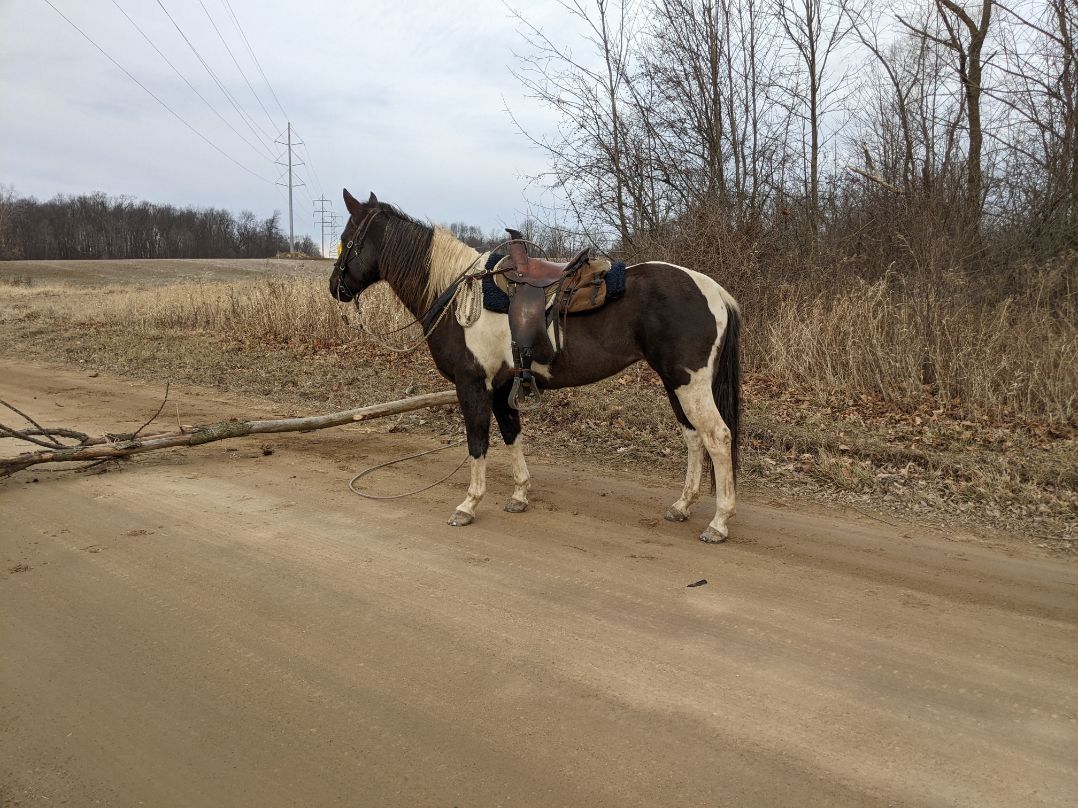
In the photo above you see my Pinto half TWH mare, Avi, on Stand-Stay - standing in the road awaiting further direction.
Best wishes in learning more "horse" (language & logic),
Certified Farrier - Colt Starting Trainer
Jack Griffes
All are invited to Come unto ChristHow to teach your horse to pick up its rider from a raised mounting platform
How to teach your horse to calmly accept the electric clippers while trimming its bridle path and pasture trimming its ears
How to teach your horse to stand perfectly calm while totally UNRESTRAINED for shoeing / trimming / etc.
How to teach your horse to Stand-Stay so it will be a better helper for you.
Start right! Safely mounting a totally green horse for the first time.
Defusing the anti-predator responses associated with mounting a horse.
One Horse-powered Snowplow
This Site's Index Page
Email me
Changes last made on: 25 April 2024
Accessed